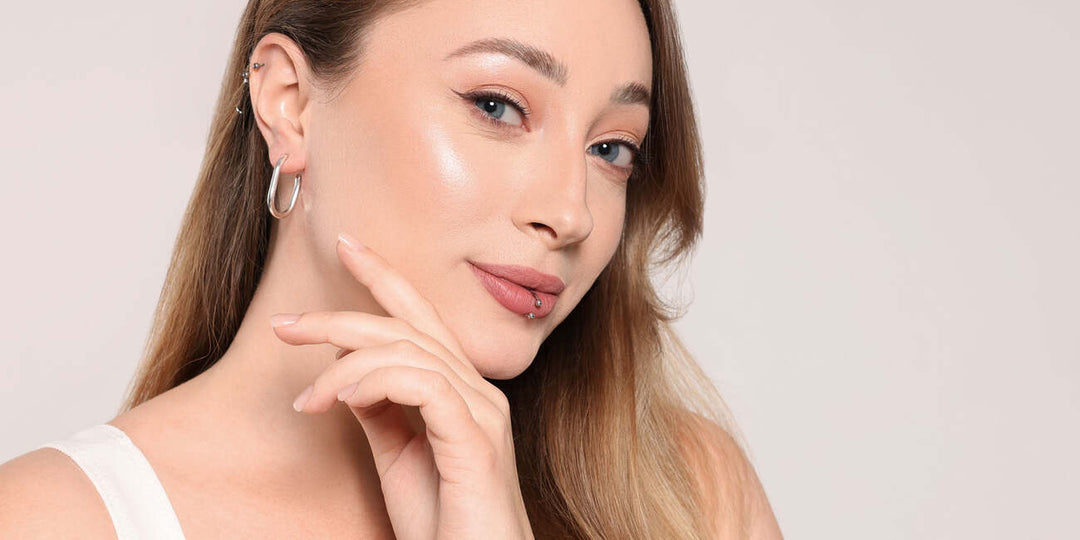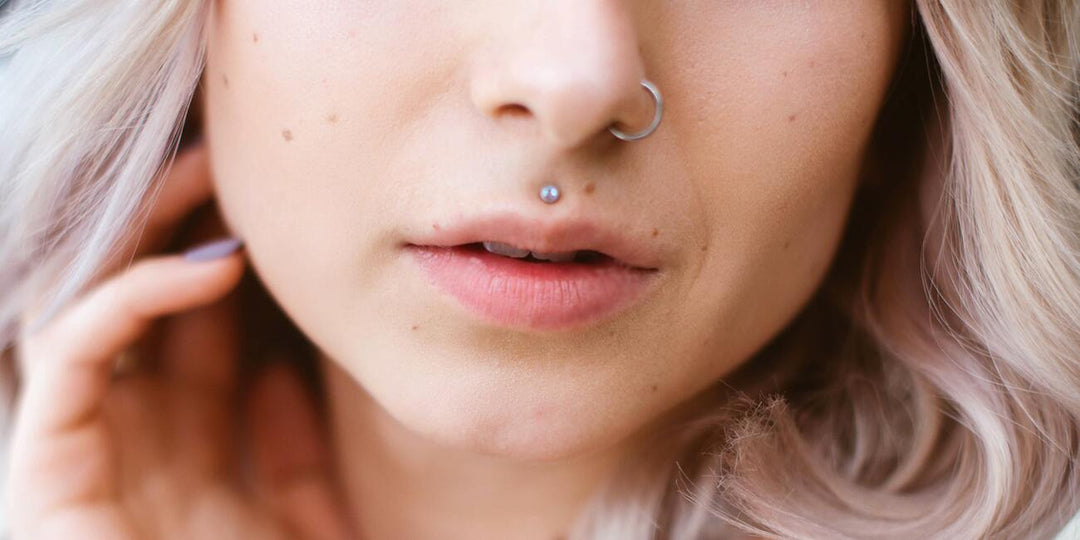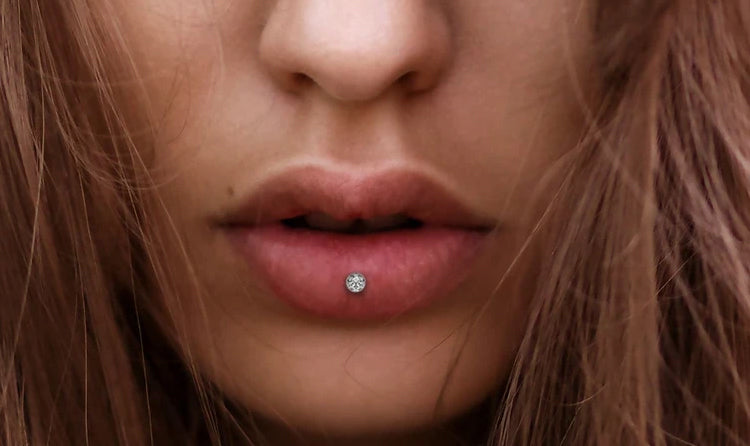The Snake Bites Piercing: Everything You Need To Know
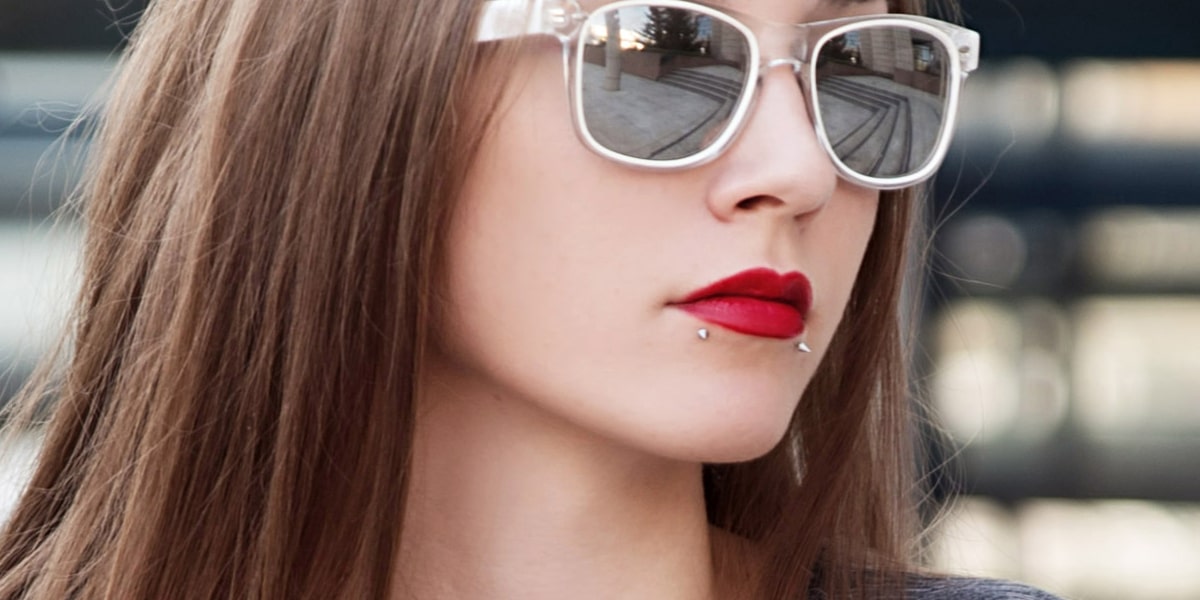

The lips offer a plethora of piercing options for you to enjoy. From the corners of the lips to the lips themselves, you can really take your lip piercing game to the next level. For those who want something a little bolder, consider the snake bites piercing.
What Is A Snake Bites Piercing?
The look of the snake bite piercing lends to its namesake; the two piercings on either side of the bottom lip are placed to emulate the look of snake fangs or what a snake bite might look like.
As it grows in popularity, the snake bite piercing has become perhaps the most misattributed piercing. Consisting of two piercings below the bottom lip and equidistant from the center of the chin, the snake bite piercing is commonly mistaken for other lip piercing types, like the spider bite piercing or the Dahlia piercing.
The snake bite piercing offers an alluring aesthetic, but it differs greatly from other piercings it gets mistaken for, so it’s important that you know exactly what you want before taking a seat in the piercer’s chair.
Here’s all you need to know about the snake bites piercing.
Pain And Healing Time
Because the snake bite piercing consists of two separate punctures, more pain is inherently associated with this piercing since you’ll have to undergo the needle twice. However, the skin beneath the lip is generally less sensitive than the skin on the lips themselves, so the individual piercings will hurt less than other lip piercing types, like the Ashley or vertical labret piercings.
Many who have received the snake bite piercing claim that there’s more discomfort during the first days after they were pierced. The lips tend to swell more than other commonly pierced areas, which leads to some pain and throbbing. Since there are two new piercings healing on either side of the bottom lip, the snake bite piercing often sees more swelling than usual, impeding speech and making it difficult to eat.
Like the labret piercing, snake bites only take around 6 - 8 weeks to heal. However, since you will have to take care of two healing punctures, the snake bite piercing is more susceptible to complications that can delay healing.
In the initial stages, you might see significant swelling across your lower lip. Because of this, you will need to be extra careful while eating or talking lest you aggravate the piercing site. It’s a good idea to take it easy for the first few days after you receive your piercing for optimal healing.
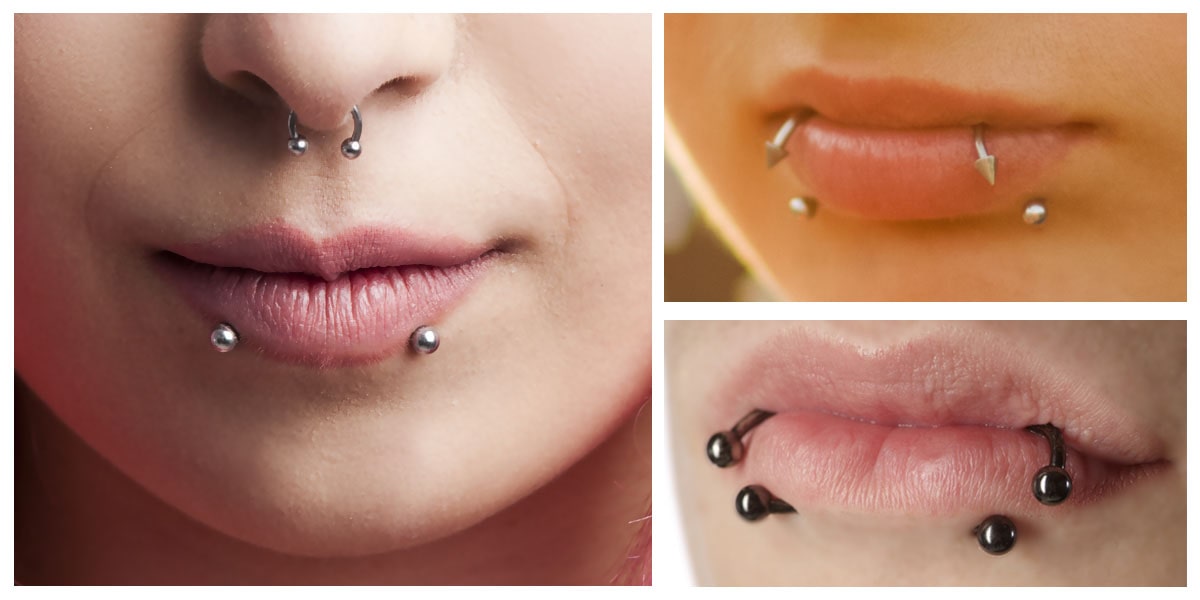

Related Products
View allAftercare
Dealing with two piercings at once shouldn’t be much different than aftercare for a single piercing, but you will have two piercings to pay attention to. The biggest aftercare difficulty will come when you eat; you won’t be able to favor one side over the other.
You might think that oral piercings have a higher risk of piercing infections, but the mouth is usually fairly clean, as long as you’re practicing proper hygiene. However, there will be other things that you will have to keep in mind.
Eat soft foods, especially during the early healing stages. The two piercing points beneath your lower lip will cause some swelling, which will make it difficult to properly move your mouth for the first few days. The swelling combined with the increased risk of chomping on your jewelry as you get used to the new hardware will make eating particularly challenging. Choose foods that are easy to chew so that you don’t accidentally bite on your jewelry or your lip, causing painful damage. Additionally, your new piercings are essentially wounds. Like any wound, you want to avoid aggravating it by rubbing salt or spicy foods on it. During the healing process, opt for mild cuisine that won’t cause undue pain.
Leave the jewelry alone. It might be especially difficult not to absentmindedly play with your two new pieces of jewelry, but this rule is essential. Not only do your fingers and tongue host harmful bacteria that could cause infections, but moving the jewelry causes trauma to the healing skin, which could lead to ugly complications like scarring or piercing rejection.
Make sure your jewelry is the right size. In the initial stages of healing, you will be fitted with a larger jewelry piece in order to make room for any swelling. As the swelling goes down, you might want to consult your piercer about switching to a smaller piece. Larger jewelry is easier to accidentally bite, and since you’ll be learning how to chew around two new pieces of jewelry, this practice will be more difficult. Once you switch to smaller jewelry, however, you need to pay attention to make sure that the jewelry does not press against the healing piercing. This can lead to embedded jewelry.
Possible Piercing Side Effects
Like all piercings, the snake bite piercing faces a few possible side effects. Luckily, all can be avoided through proper care, and almost all will eventually go away on their own. Here’s what to watch out for.
Piercing rejection may occur if your piercing has experienced trauma, if improper jewelry materials are used, or if you are improperly pierced. Signs of piercing rejection include red, flaky skin around the piercing site, enlarged piercing holes, or jewelry that’s moved noticeably. If you start to see signs of piercing rejection, visit your piercer for consultation. Unfortunately, the most likely treatment option will be to take out the jewelry, let the piercing heal, then try the piercing again later.
Piercing bumps are more common in cartilage piercings, but they can occur in fleshier areas. There are a few different types of piercing bumps—pustules, hypertrophic scarring, or irritation bumps—that almost always appear due to trauma to the piercing site or improper aftercare practices. Avoid piercing bumps by strictly following the aftercare rules laid out by your piercer and keeping any products that aren’t meant for piercing aftercare, including tea tree oil, away from your piercing. If a piercing bump appears, talk to your piercer about diagnosis and treatment.
Piercing infections are actually fairly rare, but they can occur due to poor hygiene or aftercare practices. If your piercing is painful, secretes yellow or green pus, becomes feverish, or starts to swell well after you’ve been pierced, visit your doctor immediately. Luckily, if you’ve been cleaning your piercing regularly, there’s no reason why you should develop a piercing infection.
A note on keloids: Keloids are a commonly misunderstood disorder in the piercing world. They are the result of a serious genetic disorder in which the body produces too much collagen in any injury, large or small. They are large, discolored, and must be removed using surgery. If no one in your family has ever had a keloid, and if you have never developed a keloid, it’s almost certain that the piercing bump you’re experiencing is not a keloid.
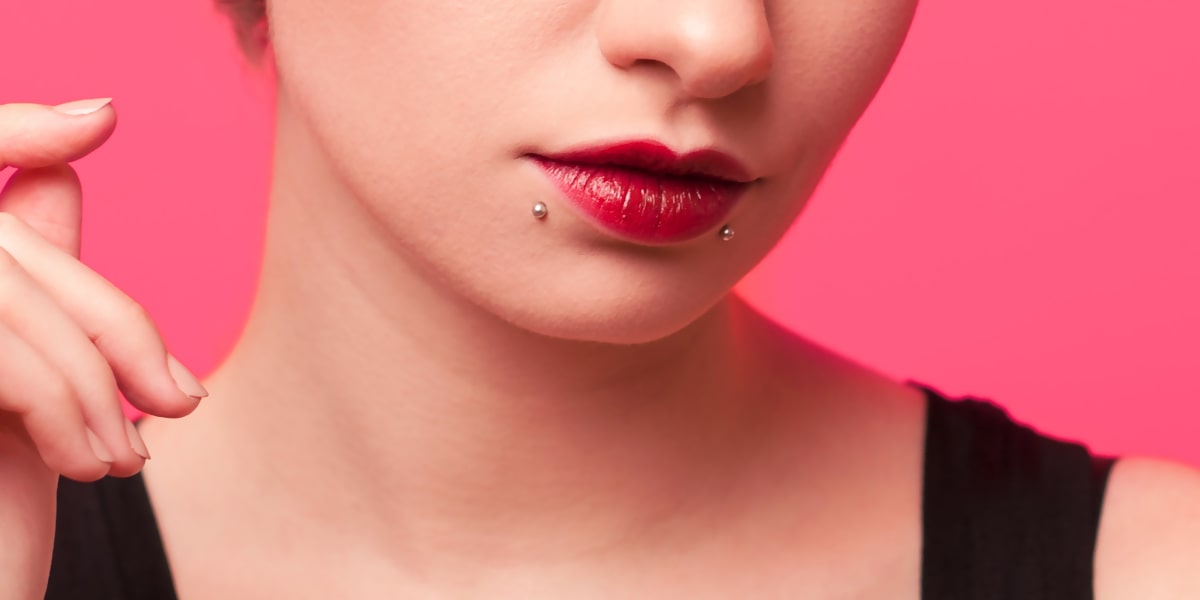

Changing Out The Piercing
Changing out your snake eyes piercing will be pretty easy. Simply unscrew the flat backing of the lip stud, unscrew the ball end of your circular barbell, or open your hoop, and slip the jewelry through. That’s it!
For a full guide on how to open jewelry types, visit our guide here.
Types Of Jewelry And Materials
The snake bites piercing allows for a wide variety of jewelry styles. It’s important to note that you will need to decide whether you’d like to opt for a labret stud or a hoop style because the shape of the piercing entry and exit points will differ. The piercer will need to know which jewelry the piercing must accommodate.
It isn’t impossible to make the switch from one jewelry type to another if you change your mind later, but it can be difficult and may cause trauma to the pierced area, so it’s not recommended. You should take some time to consider which style you prefer before visiting your piercer.
The labret stud style emulates the look of an actual snake bite. You should always choose a labret stud with a flat disc back in order to limit rubbing against the teeth and gums. Although this style seems straightforward, there are tons of labret stud types to choose from, including spiked charms, colored balls, and even prong-set diamonds.
If you choose to go for the hooped style, you still have a few jewelry types to choose from. Captive bead rings and seamless hoops seem to be among the most popular options. A seamless hoop that sits flush with the lip takes on the appearance of snake fangs, while captive bead rings put forth a similar look with the added flair of the bead.
Circular barbells are also an option. The double ball ends on each piece of jewelry makes a bold statement and draws attention to the piercing. If you’re looking for a strong fashion statement, then this could be the jewelry for you.
Typically, jewelry for the snake bites piercing comes in either 14G or 16G.
When you’re initially pierced, your starter jewelry will need to be a bit larger to accommodate swelling. You should choose a less expensive jewelry material since the initial jewelry will only be worn the first week or so. We recommend titanium because it contains few alloys, and it’s inexpensive. Once your piercing has healed a bit and swelling has gone down, switch to a nickel-free 14k gold body jewelry piece. 14k gold contains as few alloys as possible while remaining durable enough for body jewelry, and it offers a luster that few metals can emulate.
How Much Does The Snake Bites Piercing Cost?
Since you’re getting pierced twice, at around $80 - $120, the snake bites piercing is more expensive than other lip piercings.
It’s always important to choose an experienced piercer, but the symmetrical nature of the snake bites piercing requires a steady hand and a sharp eye. You don’t want to go home to discover that your brand new piercing is off-kilter. Find a piercer that you trust to do the job right.
Even if you trust your piercer, take a close look at the marks the piercer makes before performing the piercing. At the end of the day, you’re the one who will have to live with your piercing, and you want to be sure that it’s something you’ll be happy with.
Snake Bite Variations
When dealing with a double lip piercing, it’s easy to get them confused. It’s important to note that, while there are many similar piercings to the snake bites piercing (like the dolphin bite piercing that also consists of two piercings equidistant from the center of the chin but are closer together than the snake bite piercing), they are considered different piercings rather than variations of the snake bites.
Sometimes, piercing styles are mistakenly attributed to snake bites variations. The shark bite piercing, for example, is sometimes called the double snake bite piercing. Make sure that you know the correct terms so that you receive the piercing that you pictured.
That being said, the one-sided snake bite piercing is one true variation of the snake bite piercing. It consists of only one piercing on either the left or right side of the face below the bottom lip. This variation is a great option for those who might be thinking of going for a full snake bites piercing in the future but would rather deal with one healing process at a time.








